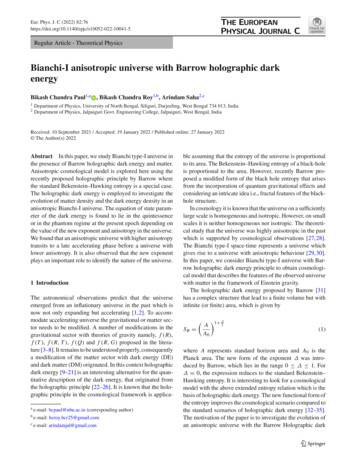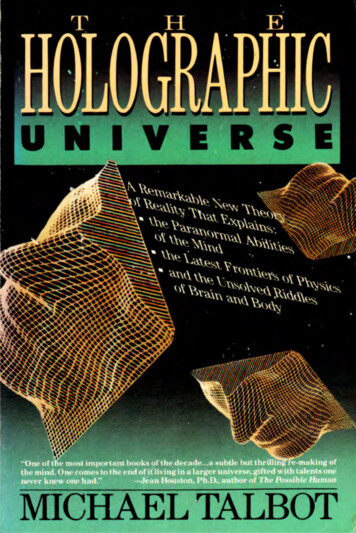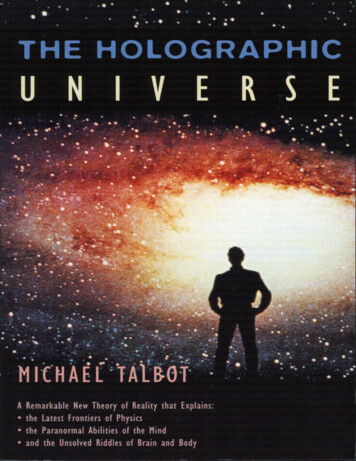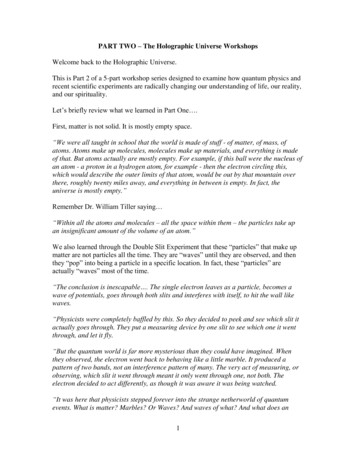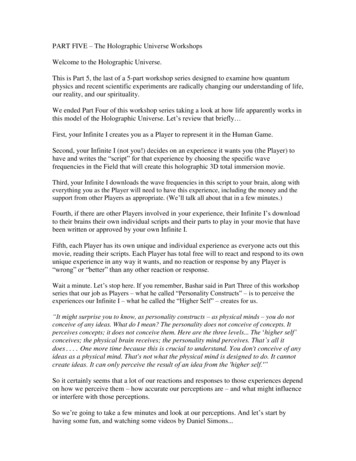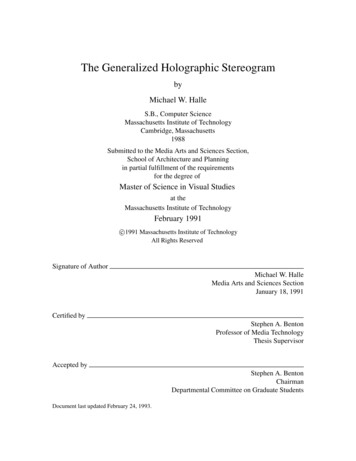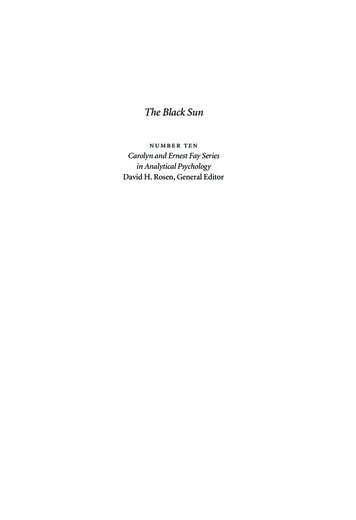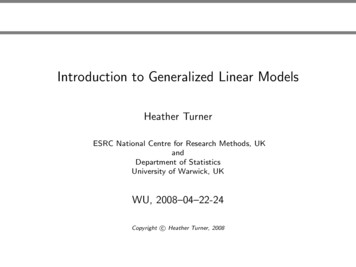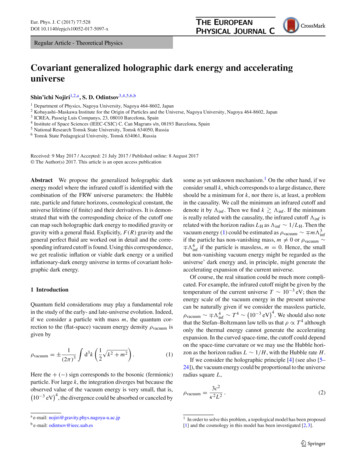
Transcription
Eur. Phys. J. C (2017) 77:528DOI 10.1140/epjc/s10052-017-5097-xRegular Article - Theoretical PhysicsCovariant generalized holographic dark energy and acceleratinguniverseShin’ichi Nojiri1,2,a , S. D. Odintsov3,4,5,6,b1Department of Physics, Nagoya University, Nagoya 464-8602, JapanKobayashi–Maskawa Institute for the Origin of Particles and the Universe, Nagoya University, Nagoya 464-8602, Japan3 ICREA, Passeig Luis Companys, 23, 08010 Barcelona, Spain4 Institute of Space Sciences (IEEC-CSIC) C. Can Magrans s/n, 08193 Barcelona, Spain5 National Research Tomsk State University, Tomsk 634050, Russia6 Tomsk State Pedagogical University, Tomsk 634061, Russia2Received: 9 May 2017 / Accepted: 21 July 2017 / Published online: 8 August 2017 The Author(s) 2017. This article is an open access publicationAbstract We propose the generalized holographic darkenergy model where the infrared cutoff is identified with thecombination of the FRW universe parameters: the Hubblerate, particle and future horizons, cosmological constant, theuniverse lifetime (if finite) and their derivatives. It is demonstrated that with the corresponding choice of the cutoff onecan map such holographic dark energy to modified gravity orgravity with a general fluid. Explicitly, F(R) gravity and thegeneral perfect fluid are worked out in detail and the corresponding infrared cutoff is found. Using this correspondence,we get realistic inflation or viable dark energy or a unifiedinflationary-dark energy universe in terms of covariant holographic dark energy.1 IntroductionQuantum field considerations may play a fundamental rolein the study of the early- and late-universe evolution. Indeed,if we consider a particle with mass m, the quantum correction to the (flat-space) vacuum energy density ρvacuum isgiven byρvacuum 1(2π )3 d3 k 1 2k m2 .2(1)Here the ( ) sign corresponds to the bosonic (fermionic)particle. For large k, the integration diverges but because theobserved value of the vacuum energy is very small, that is, 3 410 eV , the divergence could be absorbed or canceled bya e-mail:nojiri@gravity.phys.nagoya-u.ac.jpb e-mail:odintsov@ieec.uab.essome as yet unknown mechanism.1 On the other hand, if weconsider small k, which corresponds to a large distance, thereshould be a minimum for k, nor there is, at least, a problemin the causality. We call the minimum an infrared cutoff anddenote it by inf . Then we find k inf . If the minimumis really related with the causality, the infrared cutoff inf isrelated with the horizon radius L H as inf 1/L H . Then thevacuum energy (1) could be estimated as ρvacuum m 3infif the particle has non-vanishing mass, m 0 or ρvacuum 4inf if the particle is massless, m 0. Hence, the smallbut non-vanishing vacuum energy might be regarded as theuniverse’ dark energy and, in principle, might generate theaccelerating expansion of the current universe.Of course, the real situation could be much more complicated. For example, the infrared cutoff might be given by thetemperature of the current universe T 10 3 eV; then theenergy scale of the vacuum energy in the present universecan be naturally given if we consider the massless particle, 4ρvacuum 4inf T 4 10 3 eV . We should also notethat the Stefan–Boltzmann law tells us that ρ T 4 althoughonly the thermal energy cannot generate the acceleratingexpansion. In the curved space-time, the cutoff could dependon the space-time curvature or we may use the Hubble horizon as the horizon radius L 1/H , with the Hubble rate H .If we consider the holographic principle [4] (see also [5–24]), the vacuum energy could be proportional to the universeradius square L,ρvacuum 3c2.κ2 L2(2)1In order to solve this problem, a topological model has been proposed[1] and the cosmology in this model has been investigated [2,3].123
528 Page 2 of 8Eur. Phys. J. C (2017) 77:528Here κ is the gravitational coupling and c is a constant. Theproblem of the original holographic dark energy model [4]where the infrared cutoff was chosen as the size of the eventhorizon is the fact that the corresponding FRW equationsoften do not correspond to any covariant gravity theory andeven may not predict the acceleration of the universe. Subsequently, the generalized holographic dark energy has beenproposed in Ref. [25] where the infrared cutoff is identified with a combination of the FRW universe parameters:the Hubble constant, particle and future horizons, cosmological constant and universe lifetime (if finite). Implicitly, thedependence from the derivatives of the corresponding FRWparameters was also assumed. Different versions of the cutoffcorresponding to generalized holographic dark energy [25]have been considered in Refs. [26–41].In this paper, we consider a generalized holographic darkenergy with arbitrary cutoff which depends on the FRW universe parameters for the vacuum energy density ρvacuum . Infact, the choice of the infrared cutoff could be included in thedefinition of the quantum theory in curved space-time. Therefore, unitarity and causality could give important hints to findthe correct definition of the infrared cutoff. The AdS/CFTcorrespondence might also give some indication because theinfrared cutoff could be related with the ultraviolet cutoff inthe corresponding gauge theory. However, there is no definite prediction at all for the choice of the infrared cutoff atleast at present. Then we consider several possibilities forthe cutoff choice. In the next section, we briefly review theholographic dark energy and introduce the covariant generalized holographic dark energy model. Section 3 is devotedto generalized holographic dark energy which is equivalentto F(R) gravity. In this way, consistent inflation naturallyemerges from the covariant generalized holographic darkenergy. In the last section, the reconstruction of the arbitraryfluid as generalized holographic dark energy is developed.The occurrence of a dark energy universe or even a unifiedinflation–dark energy universe in terms of such a theory isdemonstrated.2 Generalized holographic dark energyLet us consider the spatially flat FRW universeds 2 dt 2 a(t)2 dx i2.(3)i 1,2,3Defining the Hubble rate H ȧ(t)/a(t), the first FRW equation has the following form:3 2H ρ ,κ2which gives123(4)H c.L(5)Here we assume that c is positive constant because theexpanding universe is considered. It is well known that ifone chooses the infrared cutoff inf to be the Hubble rateH , the accelerating universe cannot be realized. There aremore possibilities for the choice of the infrared radius L. Forexample, one may choose L to be the particle horizon L p orthe future horizon L f , which is defined by t dt dt ,L.(6)L p (t) a(t)(t) a(t)f a(t )0 a(t )tFor the FRW metric with the flat spatial part in (3), by choosing L as L p or L f , we find the following equation: c1d .(7)dt a(t)H (t)a(t)Here, the ( ) sign corresponds to the particle (future) horizon. We can easily solve Eq. (7) and finda(t) a0 t h 0 ,(8)withh0 11 1c.(9)Then, in the case L L f , the universe is acceleratingbecause h 0 1. When c 1, in the case L L p , h 0becomes negative and the universe is shrinking. If one canchange the direction of time as t ts t, instead of (8), wefinda(t) a0 (ts t)h 0 .(10)Then there will be a Big Rip singularity at t ts . Because wechange the direction of time, the particle horizon becomes afuture-like one, tsdt da a(t). (11)L p (t) L̃ f (t) a(t) 2t a(t )a(t) H aNote that if we choose L as a future horizon L L f , thereis a solution describing the de Sitter space-time, t1H .(12)a(t) a0 e llIf we choose, however, the particle horizon as L, the solutiondescribing the de Sitter space-time does not exist. Additionally to the fact that not all choices of cutoff may lead to theaccelerating universe, it is easy to see that the corresponding FRW equations cannot be obtained from some covariantaction.
Eur. Phys. J. C (2017) 77:528Page 3 of 8 528In general, L could be a combination (a function) of bothL p and L f [42]. Furthermore, if there is a Big Rip singularityat t ts and therefore the lifetime of the universe is finite, Lcan also be a function of ts . More general, it could be the casethat L depends on the Hubble rate H and also the curvatureas we have mentioned (see also Ref. [25]), L L L p , L̇ p , L̈ p , . . . , L f , L̇ f , L̈ f , . . . , ts , H, Ḣ , Ḧ , . . . .1R11 1 22L12 2h1 h 21t021 h 20h 211h0 L 2 h11 2t0t0L 2f .(17)Even in the model (17), the Hubble rate H (15) is again thesolution. Hence, generalized holographic dark energy mayunify the inflation with dark energy.(13)3 Holographic description of F(R) gravitySome of the cutoffs given by (13) cannot be obtained fromthe covariant gravity theory. Still such a possibility should notbe excluded because the FRW background breaks the covariance or at least the Lorentz symmetry, in some sense, spontaneously. A similar example might be the Casimir force,which could also appear because we break Lorentz invariance by the boundary conditions. We call the theory with theabove cutoff covariant generalized holographic dark energyin the case where it may be equivalently described by somecovariant theory. Later on, we shall give some examples ofsuch a theory where the equivalence with modified gravityor fluid theory is established.Let us demonstrate that the above model may unify theearly-time inflation and the current accelerating expansionof the universe. We consider the case that c 1 and L isgiven by 12h 0h111 1 Lt0 h 0 L ft0 h 1t01 h 20h 21Lf.(14)th1 t0t0 h 0 h 1 tanhtt0cosh2BecauseL̇ p H L p 1,L̇ f H L f 1,tt0. (15)H L̇ pL̇ f11 ,LpLpLfLfḢ L̇ 2fL̇ 2pL̇ pL̈ fL̇ fL̈ p 2 2 2 2,LpLpLpLfLfLf 3L̈ pL̇ p1 2 2LpLpLpL̇ fL̈ f1 2 2LfLfLf Ri j a 2 Ḣ 3H 2 g̃i j a 2 a2Then at the early universe t , the Hubble rate H goesto a constant H h 0 h 1 , which may be identified withthe inflation and at the late universe t , H goes toa constant again, H h 0 h 1 , which may be identifiedwith the late-time accelerating expansion.Instead of (14), by using the scalar curvature R 6 2H 2 Ḣ , we maydiscuss the model 6,2 L̇ 2pL̈ p5 L̇ p3 2 2 2LpLpLpLp2 L̇ 2fL̈ f5 L̇ f3 2 2 2LfLfLfLfR 6 Ḣ 12H 2 R L 6(16)(20)and thereforeIn fact, one can check that1t h 0 h 1 tanh .Lft0(19)we find Rtt 3 Ḣ H 2 3Here L f is a future horizon defined by (6) and t0 , h 0 , and h 1are positive constants and it is assumed that h 0 h 1 . Thenthe solution of the first FRW equation is given byH h 0 h 1 tanhLet us now demonstrate the correspondence between the generalized holographic dark energy of the previous section andF(R) gravity with the action 114 S 2 d x g F(R) 2 d4 x g (R f (R)) .2κ2κ(18)g̃i jg̃i j ,L̇ 2pL̈ p3 L̇ p2 2 2 2LpLpLpLpL̇ 2fL̈ f3 L̇ f2 2 2 2LfLfLfLf.(21)In the case of F(R) gravity (for a general review, see [43,44])we have the following FRW equations:f (R) 3 H 2 Ḣ f (R)2d f (R) 3H κ 2 ρmatter ,dt3H 2 123
528 Page 4 of 8Eur. Phys. J. C (2017) 77:528f (R) Ḣ 3H 2 f (R)2d f (R) d2 f (R) 6H κ 2 pmatter .dtdt 2For the model (24), one gets 3H 2 2 Ḣ .2 L̈ p L̇ 2pL̈ 2p2 L p L̇ p2L p4 L̈ p L̇ pc2 18α κ2 L2L 2pL 2pL 3pL 2pL 3p(22)3 L̇ 4p14 L̇ 3p21 L̇ 2p8 L̈ p10 L̇ p L 3pL 4pL 4pL 4pL 4p Using the holographic language, we may rewrite (63) as follows:3H 2 f (R L ) 32 3L̇ p1 LpLpf (R L ) 32 3 3H 2 2 Ḣ L̇ f1 LfLff (R L ) 2 6L̈ pL̇ p1 2 2LpLpLpf (R L )d f (R L ) κ 2 ρmatter ,dtL̇ fL̈ f1 2 2LfLfLfL̇ p1 LpLpf (R L ) 2f (R L )d f (R L ) d2 f (R L ) dtdt 2 62 L̇ 2f5 L̇ fL̈ f3 2 2 2LfLfLfLfL̇ f1 LfLff (R L )(28)0 ρ̇ 3H (ρ p) ρ̇ 3H h(ρ),(29)can be rewritten as follows:(23)The above correspondence clearly shows how the arbitraryF(R) gravity may be mapped into the covariant generalized holographic dark energy. Similarly, the equivalence withother modified gravities like modified Gauss–Bonnet gravity,non-local gravity, string-inspired theory may be established.As an example, we consider the case thatf (R) α R 2 ,p ρ h(ρ).Here p is the pressure and ρ is the energy density and h(ρ)is a function of the energy density ρ. By using (20), theconservation law,d f (R L ) d2 f (R L ) dtdt 2 κ 2 pmatter .Hence, the correspondence between the F(R) gravity andthe covariant generalized holographic dark energy modelsis established. This equivalence shows how to describe theaccelerating universe in terms of generalized holographicdark energy.One may further develop the correspondence between theholographic dark energy and the perfect fluid. The equationof state (EoS) of the general perfect fluid is given byd f (R L ) κ 2 ρmatter ,dt κ 2 pmatter (27)4 Generalized holographic dark energy description ofperfect fluidf (R L )2 L̇ 2pL̈ p5 L̇ p3 2 2 2LpLpLpLp.(24)L̇ p1 LpLp0 ρ̇ 3h(ρ) ρ̇ 3L̇ f1 LfLfh(ρ),(30)which givesLpln L0 tLfdt ln LpL0 tdt1 Lf3 dρ.h(ρ)(31)Here L 0 is a constant which is introduced due to a dimensional considerations. Equation (31) can be algebraicallysolved with respect to ρ, Lf ρ ln L0 with a constant α. This Starobinsky inflation model gives thefollowing spectral index n s and the scalar–tensor ratio r [45]: Lp ρ ρ lnL0n s 0.967, r 3.33 10 3 ,which is consistent with results in Planck 2015 [46],Then we find that the perfect fluid is also described by theholographic language.As a first simple example, we may consider the fluid withconstant EoS parameter w, p wρ, that is,n s 0.968 0.006 (68% CL), r 0.11 (95% CL). (26)h(ρ) (1 w) ρ,123(25)tdtLptdtLf. (32)(33)
Eur. Phys. J. C (2017) 77:528Page 5 of 8 5282which gives a(t) t 3(w 1) . Then Eq. (31) giveslnLp L0 tLfdt ln LpL0 parameter. Because Eq. (39) can be solved with respect to tas follows:ρdt1ln , Lf3 (1 w) ρ0(34)t J J 2 4J1 J2,t 2J1(42)Eq. (38) givesthat is, ρ ρ0 ρ0LpL0LfL0 3(1 w)e 3(1 w) 3(1 w)e3(1 w) t t κ 2ρ κ 2ρ1 κ 2ρ 4J1 J2 .h(ρ) 2κ J2333dtLpdtLf.(35)For general perfect fluid, by using the FRW equations3ρ 2 H 2,κ1p 2 2 Ḣ 3H 2κ(36)We should note that the sign corresponds to the sign inEq. (42). Then Eq. (31) givesln(37)Equation (37) can be regarded as a generalized equation ofstate, whereh(ρ) 2 Jκ2 ρ 1Jκ.3(38)In general, it is difficult to write down the explicit form ofh(ρ) for general J (t) and also to solve (31) explicitly. Wenow just give an example, whereJ (t) J1 t J2 t 1 .(39)By using (37), we may define the effective EoS parameterweff byweff2 Ḣp 1 .ρ3H 2(40)Then H J (t) in (39) givesweff 2 J1 J2 t 2 1 2 .3 J1 t J2 t 1 tLfdtdt ln LpL0Lf κ 2ρ κ 2ρ1dρ κ 2 ρ 4J1 J2 . 4J1ρ333Lp L0one can reconstruct the holographic cutoff. If the Hubblerate H is given as a function of the cosmological time t,H J (t), we have ρ2 1κ.p ρ 2 J Jκ3(43) t(44)It is a little bit tedious to execute the integration and ratherdifficult to solve Eq. (44) with respect to ρ analytically.In Ref. [47], the following EoS was investigated: βp 1 3 ρ G3β,κ2(45)with constants β and G 3 . The EoS fluid (45) gives the following Hubble rate:H 2 G 2aβ G 3 .(46)With the EoS (45), h(ρ) in (28) is given byβG3βh(ρ) ρ 2 .3κ(47)Then Eq. (31) gives t t LpLfdtdt1dρln ln 3βL0LpL0Lfβρ 3Gβκ 2 3G 3 β1 ρ βκ 2 ,(48) lnβρ0(41)One finds, for t , that weff 1, which correspondsto the accelerating expansion. On the other hand, when t 0, weff behaves as weff 1 3J22 . Especially if J2 23 ,the effective EoS parameter weff coincides with the dust EoSand we obtainρ 3G 3 β ρ0βκ 23G 3 β ρ0βκ 2 LpL0LfL0 βeβ βe t β Ldtp tdtLf.(49)123
528 Page 6 of 8Eur. Phys. J. C (2017) 77:528This shows the equivalence of the specific perfect fluid universe with covariant generalized holographic dark energy forthe specific cutoff.Furthermore, in Ref. [48], the following EoS was proposed:p ρ 2 · 3 α 12αακ α 1αf 02 α ρα 12α.(50)Here α and f 0 are constants. The universe inspired by theEoS fluid (50) evolves with the following Hubble rate:f0or a(t) e α 1 f0 ts t H (t) f 0 ts t αα 1.(51)The form of the Hubble rate (51) shows (see [49]): ακ α 1αf 02 α ρα 12αh (ρ (t)) e l3 (1 a(t))2κ 2 l3at the late.(56)As Eq. (55) can be solved with respect to a(t) asa(t) h(ρ) As the EoS fluid (50) givesα 12ακ 2 eet 3 at the early universe and a(t) etuniverse. The conservation law (29) gives e ρ(t),ρ(t) l(57)one getsIf 1 α 21 , a Type III singularity occurs.If α 1, a Type I singularity appears.If α 1, a Type IV singularity occurs.If 21 α 1, a Type II singularity occurs.h(ρ) 2 · 3 a , ρ goes to a constant ρ l . Hence, at the earlyuniverse and at the late universe, the asymptotically de Sitteruniverseis realized. The scale factor a behavesas a(t) ,(52)(ρ l )2.3 ( e l )(58)Equation (31) gives t tLpLfdtdtln ln ( e l )L0LpL0Lf dρ( e l ) ,2ρ l(ρ l )(59)Eq. (31) leads to t LfLpdt ln lnL0LpL0 2·33α 12αα 12αtwhich can be solved with respect to ρ as follows:dtLf1 dρα 1ακ α f 02 α1(α 1) κ α 1αα 12αρf 02 αThen we find α 1α 1Lpρ 3 2α (α 1) κ α f 02 α ln L0 α 1Lf2 α α 12ααln 3f0 (α 1) κL0ρ l ρα 12αtdtLptdtLf. (53)2α α 12α α 1( e l )( e l ) t dt l L f t dt .Lpln L 0 ln L 0 LpLf(60)Thus, we succeed to establish the correspondence betweenthe general perfect fluid with Einstein gravity and the covariant generalized holographic dark energy model. Due tothe well-known equivalence between the fluid descriptionand the scalar–tensor description (for a review, see [50])one can extend the above correspondence to scalar–tensortheory.5 Discussion(54)Again, the holographic description of the above perfect fluidis established.As an example which unifies the inflation and the latetime accelerating expansion, one may consider the followingmodel:ρ(t) e l a(t).1 a(t)(55)At the early universe, where a(t) 0, we find that ρ goesto a constant, ρ e and even at the late universe, where123In summary, we proposed the generalized holographic darkenergy model where the infrared cutoff is identified with acombination of the FRW parameters: the Hubble rate, particle and future horizons, cosmological constant and universelifetime and the derivatives of the corresponding parameters. It is pointed out that, for simple and natural choices ofthe infrared cutoff, motivated by the considerations of theunitarity and causality or AdS/CFT related hints, the emerging universe may be not accelerating. Furthermore, it oftenhappens that such a holographic model does not admit thecovariant description. However, as we demonstrate in this
Eur. Phys. J. C (2017) 77:528Page 7 of 8 528letter, with a more complicated choice of the infrared cutoffone can map the (covariant) generalized holographic darkenergy to the modified gravity or to general relativity with aquite general fluid. Specifically, the examples of the arbitraryF(R) gravity and perfect fluids are worked out in detail. Itis explicitly shown how to get the realistic inflationary universe, or a viable dark energy universe or even the unification of the inflation with dark energy epoch in the frameworks of specific covariant generalized holographic darkenergy.The results of this letter give a clear recipe on how torewrite the arbitrary modified gravity including the scalar–tensor theory or gravity theory with fluid matter as the covariant holographic model. It may indicate that different descriptions of the universe evolution may have a common originrelated with a yet not fully understood symmetry somehowrelated with holography.We have established that F(R) gravity can be rewritten inthe holographic language at the level of background equivalence. Then it might be interesting if we consider the equivalence at the perturbation level. In the standard formulation ofthe holographic dark energy, the infrared cutoff only dependson the time coordinate but the scalar curvature also dependson the space coordinates. Hence, in Eq. (21), L p or L f shouldalso depend on the space coordinates when we consider theperturbation, although L p and L f should be usually spatiallyconstant in the standard holographic dark energy. This indicates that there is no equivalence at the perturbation levelbetween the holographic dark energy and the F(R) gravity.We expect that the spectral index n s and the scalar–tensorratio r are the same in both models but cosmological perturbations theory may lead to different results. Furthermore,the infrared cutoff can depend on the point where we areconsidering the theory. For example, near a black hole, theinfrared cutoff should depend on the spatial coordinates inaddition to the time coordinate. Such an infrared cutoff couldalso depend on the non-local quantities as the position of theblack hole or the local fluctuation of the expansion and therefore it could be rather difficult to formulate the perturbationin such a complicated case.As another example of the dark energy models, we mayconsider the viscous dark energy model (see [51] and thereferences therein) where a bulk viscosity in the cosmic fluidgenerates the accelerating expansion of the universe. In theviscous dark energy model, the conservation law of the fluidis modified by the bulk viscosity ζ as follows:ρ̇ 3H (ρ p) 9ζ H 2 .(61)Then the FRW equations are modified as follows:3H 2 κ 2 ρ, 3H 2 2 Ḣ κ 2 ( p 3ζ H ) .(62)By comparing Eq. (62) with Eq. (63), we may identify f (R)d f (R)12 3 H Ḣ f (R) 3H,ρ 2 κ2dt 1 f (R)d f (R)p 2 Ḣ 3H 2 f (R) 6Hκ2dt 2 d f (R) 9ζ H 2 .(63)dt 2In the holographic view point, H can be given by the infraredcutoff as shown in (20). Therefore the conservation law ofthe fluid in (61) can be further rewritten asρ̇ 3H (ρ p) ρ̇ 3 9ζL̇ p1 LpLp ρ̇ 3 9ζL̇ p1 LpLp(ρ p)2L̇ f1 LfLfL̇ f1 LfLf(ρ p)2.(64)Further by using a more general infrared cutoff in (13), wemay write (61) as follows: 2ρ̇ 3H (ρ p) 9ζ H L , L̇, L̈, . . . , ts , . . . .(65)This indicates that viscous dark energy may be related withthe holographic dark energy or vice versa.It might also be interesting to consider the holographicdark energy in the brane cosmology [39,52,53]. In D dimensional space-time, the total energy in the region with a radiusr does not exceed the mass of the maximum black hole in theregion. In terms of the Schwarzschild radius rs , the mass Mis proportional to rsD 3 , M rsD 3 ; then the energy densityρ is restricted toρ M rs r r 2 .V(66)Here V is the volume of the region, which is proportionalto r D 1 . Then by choosing r to be the infrared cutoff L, wefind ρ L 2 . Hence, if we consider the D 1 dimensionalbrane in the D dimensional bulk space-time, an energy density which is proportional to L 2 is induced, and its behaviorcoincides with the behavior of the four dimensional holographic dark energy in (2). Therefore F(R) or any othermodified gravity in the bulk and/or the brane can be rewritten as the holographic dark energy. This will be consideredelsewhere.123
528 Page 8 of 8Acknowledgements This work is supported (in part) by MEXT KAKENHI Grant-in-Aid for Scientific Research on Innovative Areas “Cosmic Acceleration” (No. 15H05890) (SN) and by MINECO (Spain),Project FIS2013-44881, FIS2016-76363-P(SDO) and by CSIC ILINK1019 Project (SDO and SN).Open Access This article is distributed under the terms of the CreativeCommons Attribution 4.0 International License (http://creativecommons.org/licenses/by/4.0/), which permits unrestricted use, distribution,and reproduction in any medium, provided you give appropriate creditto the original author(s) and the source, provide a link to the CreativeCommons license, and indicate if changes were made.Funded by SCOAP3 .References1. S. Nojiri, Mod. Phys. Lett. A 31(37), 1650213 (2016). doi:10.1142/S0217732316502138. arXiv:1601.02203 [hep-th]2. R. Saitou, Y. Gong, arXiv:1702.02806 [hep-th]3. T. Mori, D. Nitta, S. Nojiri, arXiv:1702.07063 [hep-th]4. M. Li, Phys. Lett. B 603, 1 (2004). doi:10.1016/j.physletb.2004.10.014. arXiv:hep-th/04031275. Q.G. Huang, Y.G. Gong, JCAP 0408, 006 (2004). doi:10.1088/1475-7516/2004/08/006. arXiv:astro-ph/04035906. B. Wang, E. Abdalla, R.K. Su, Phys. Lett. B 611, 21 (2005). doi:10.1016/j.physletb.2005.02.026. arXiv:hep-th/04040577. Y.S. Myung, Mod. Phys. Lett. A 20, 2035 (2005). doi:10.1142/S0217732305018190. arXiv:hep-th/05010238. Y.S. Myung, Phys. Lett. B 626, 1 (2005). doi:10.1016/j.physletb.2005.09.003. arXiv:hep-th/05021289. K. Enqvist, M.S. Sloth, Phys. Rev. Lett. 93, 221302 (2004). doi:10.1103/PhysRevLett.93.221302. arXiv:hep-th/040601910. S.D.H. Hsu, A. Zee, Mod. Phys. Lett. A 20, 2699 (2005). doi:10.1142/S0217732305018839. arXiv:hep-th/040614211. M. Ito, Europhys. Lett. 71, 712 (2005). doi:10.1209/epl/i2005-10151-x. arXiv:hep-th/040528112. P.F. Gonzalez-Diaz, arXiv:hep-th/041107013. Q.G. Huang, M. Li, JCAP 0503, 001 (2005). doi:10.1088/1475-7516/2005/03/001. arXiv:hep-th/041009514. S. Nobbenhuis, Found. Phys. 36, 613 (2006). doi:10.1007/s10701-005-9042-8. arXiv:gr-qc/041109315. Y.G. Gong, B. Wang, Y.Z. Zhang, Phys. Rev. D 72, 043510 (2005).doi:10.1103/PhysRevD.72.043510. arXiv:hep-th/041221816. A.J.M. Medved, Mod. Phys. Lett. A 21, 319 (2006). doi:10.1142/S0217732306019633. arXiv:hep-th/050110017. X. Zhang, Int. J. Mod. Phys. D 14, 1597 (2005). doi:10.1142/S0218271805007243. arXiv:astro-ph/050458618. Y.G. Gong, Y.Z. Zhang, Class. Quantum Gravity 22, 4895 (2005).doi:10.1088/0264-9381/22/22/014. arXiv:hep-th/050517519. T.Padmanabhan,doi:10.1142/9789812700988 0007.arXiv:gr-qc/050310720. B. Guberina, R. Horvat, H. Stefancic, JCAP 0505, 001 (2005).doi:10.1088/1475-7516/2005/05/001. arXiv:astro-ph/050349521. F. Arevalo, P. Cifuentes, S. Lepe, F. Peña, Astrophys. Sp. Sci. 352,899 (2014). doi:10.1007/s10509-014-1946-3. arXiv:1308.5007[gr-qc]22. L.P. Chimento, M.G. Richarte, Phys. Rev. D 85, 127301 (2012).doi:10.1103/PhysRevD.85.127301. arXiv:1207.1492 [astroph.CO]23. Z. Zhang, M. Li, X.D. Li, S. Wang, W.S. Zhang, Mod. Phys.Lett. A 27, 1250115 (2012). doi:10.1142/S0217732312501155.arXiv:1202.5163 [astro-ph.CO]24. X. Zhang, F.Q. Wu, Phys. Rev. D 72, 043524 (2005). doi:10.1103/PhysRevD.72.043524. arXiv:astro-ph/0506310123Eur. Phys. J. C (2017) 77:52825. S. Nojiri, S.D. Odintsov, Gen. Relat. Gravit. 38, 1285 (2006).doi:10.1007/s10714-006-0301-6. arXiv:hep-th/050621226. L.N. Granda, A. Oliveros, Phys. Lett. B 669, 275 (2008). doi:10.1016/j.physletb.2008.10.017. arXiv:0810.3149 [gr-qc]27. M. Khurshudyan, Astrophys. Sp. Sci. 361(12), 392 (2016). doi:10.1007/s10509-016-2981-z28. S. Wang, Y. Wang, M. Li, arXiv:1612.00345 [astro-ph.CO]29. M. Khurshudyan, Astrophys. Sp. Sci. 361(7), 232 (2016). doi:10.1007/s10509-016-2821-1. arXiv:1606.05264 [gr-qc]30. A. Khodam-Mohammadi, M. Malekjani, Mod. Phys. Lett.A 27, 1250100 (2012). doi:10.1142/S0217732312501003.arXiv:1201.3200 [hep-th]31. M.H. Belkacemi, M. Bouhmadi-Lopez, A. Errahmani, T. Ouali,Phys. Rev. D 85, 083503 (2012). doi:10.1103/PhysRevD.85.083503. arXiv:1112.5836 [gr-qc]32. L. Zhang, P. Wu, H. Yu, Eur. Phys. J. C 71, 1588 (2011). doi:10.1140/epjc/s10052-011-1588-333. M.R. Setare, M. Jamil, Gen. Relat. Gravit. 43, 293 (2011). doi:10.1007/s10714-010-1087-0. arXiv:1008.4763 [gr-qc]34. K. Nozari, N. Rashidi, Int. J. Mod. Phys. D 19, 219 (2010). doi:10.1142/S021827181001635X. arXiv:0912.4802 [gr-qc]35. A. Sheykhi, Phys. Lett. B 681, 205 (2009). doi:10.1016/j.physletb.2009.10.011. arXiv:0907.5458 [hep-th]36. L. Xu, J. Lu, W. Li, Eur. Phys. J. C 64, 89 (2009). doi:10.1140/epjc/s10052-009-1122-z. arXiv:0906.0210 [astro-ph.CO]37. H. Wei, Nucl. Phys. B 819, 210 (2009). doi:10.1016/j.nuclphysb.2009.04.020. arXiv:0902.2030 [gr-qc]38. M.R. Setare, E.N. Saridakis, Phys. Lett. B 670, 1 (2008). doi:10.1016/j.physletb.2008.10.029. arXiv:0810.3296 [hep-th]39. E.N. Saridakis, Phys. Lett. B 661, 335 (2008). doi:10.1016/j.physletb.2008.02.032. arXiv:0712.3806 [gr-qc]40. M.R. Setare, Phys. Lett. B 644, 99 (2007). doi:10.1016/j.physletb.2006.11.033. arXiv:hep-th/061019041. F. Felegary, F. Darabi, M.R. Setare, arXiv:1612.03406 [gr-qc]42. E. Elizalde, S. Nojiri, S.D. Odintsov, P. Wang, Phys.Rev. D 71, 103504 (2005). 243. S. Nojiri, S.D. Odintsov, Phys. Rep. 505, 59 (2011). doi:10.1016/j.physrep.2011.04.001. arXiv:1011.0544 [gr-qc]44. S. Capozziello, M. De Laurentis, Phys. Rep. 509, 167 (2011).doi:10.1016/j.physrep.2011.09.003. arXiv:1108.6266 [gr-qc]45. G. Hinshaw et al. [WMAP Collaboration], Astrophys. J.Suppl. 208, 19 (2013). doi:10.1088/0067-0049/208/2/19.arXiv:1212.5226 [astro-ph.CO]46. P.A.R. Ade et al. [BICEP2 and Keck Array Collaborations],Phys. Rev. Lett. 116, 031302 (2016). doi:10.1103/PhysRevLett.116.031302. arXiv:1510.09217 [astro-ph.CO]47. K. Bamba, S. Nojiri, S.D. Odintsov, D. Sáez-Gómez, Phys.Rev. D 90, 124061 (2014). doi:10.1103/PhysRevD.90.124061.arXiv:1410.3993 [hep-th]48. S. Nojiri, S.D. Odintsov, V.K. Oikonomou, Phys. Lett. B 747, 310(2015). doi:10.1016/j.physletb.2015.06.016. arXiv:1506.03307[gr-qc]49. S. Nojiri, S.D. Odintsov, S. Tsujikawa, Phys. Rev. D 71, 063004(2005). doi:10.1103/PhysRevD.71.063004. arXiv:hep-th/050102550. K. Bamba, S. Capozziello, S. Nojiri, S.D. Odintsov, Astrophys. Sp. Sci. 342, 155 (2012). doi:10.1007/s10509-012-1181-8.arXiv:1205.3421 [gr-qc]51. I. Brevik, Ø. Grøn, J. de Haro, S.D. Odintsov, E.N. Saridakis,arXiv:1706.02543 [gr-qc]52. E.N. Saridakis, JCAP 0804, 020 (2008). doi:10.1088/1475-7516/2008/04/020. arXiv:0712.2672 [astro-ph]53. E.N. Saridakis, Phys. Lett. B 660, 138 (2008). doi:10.1016/j.physletb.2008.01.004. arXiv:0712.2228 [hep-th]
emerges from the covariant generalized holographic dark energy. In the last section, the reconstruction of the arbitrary fluid as generalized holographic dark energy is developed. The occurrence of a dark energy universe or even a unified inflation-dark energy universe in terms of such a theory is demonstrated. 2 Generalized holographic .
